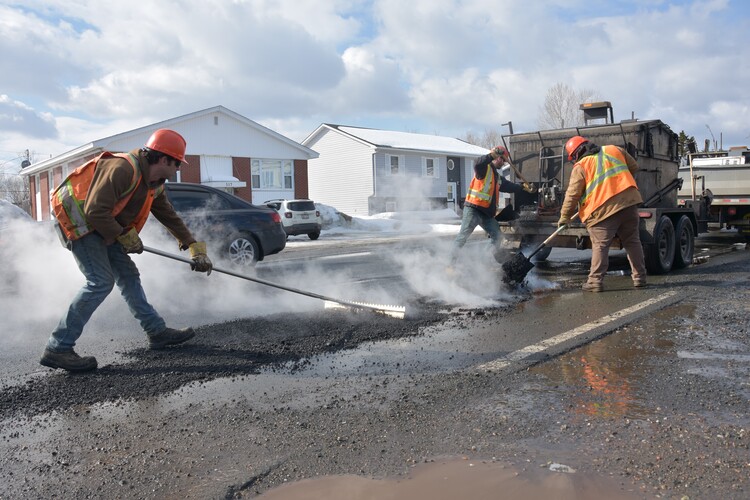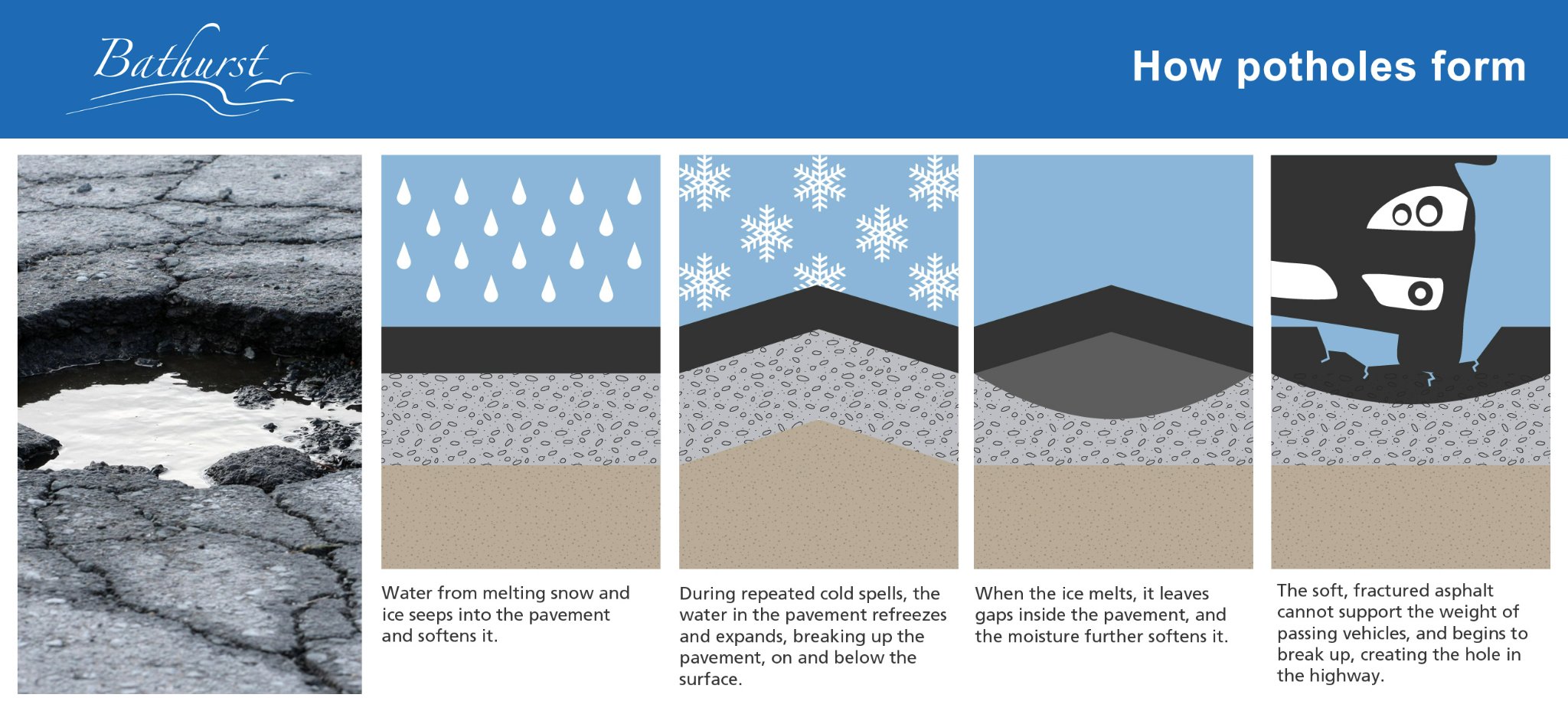Potholes and Road Patching Program

Are you looking to report a pothole?Ward 1: 1-506-548-0400 (City of Bathurst)Ward 2: 1-833-384-4111 (DTI)Presently, a pothole has to be reported to the authority associated to the specific ward. See our Local Governance Reform FAQ for more information. (Note: this is subject to change.) For more information related to claims, click here.
IT’S A POTHOLE LIFE, FOR US
Driving in late winter (or early spring) in northern New Brunswick can sometimes feel like trying to solve a 1000-piece puzzle, except all the pieces are potholes and no one is really having fun. If you make it through the season without spilling your coffee, or bending a rim, you’re usually off to a good start.
The present situation with potholes in Bathurst is no exception to this. Potholes can often form at an alarming high rate with the freeze-thaw weather patterns — as well as the rain — typical to our region.
Believe us: we clearly understand your frustrations because we feel them too!
The constant threat of potholes is the reason why the City of Bathurst has a seasonal road patching program, with multiple defined phases to help deal efficiently with potholes.
THE ROAD PATCHING PROGRAM
The City of Bathurst’s Road Patching Program is typically activated in late winter / early spring. This is because weather conditions greatly affect the public works crews’ ability to properly repair a pothole; the drier the conditions, the more efficient the road patching will be.
To better understand our road patching approach, we’ve divided it into the following 3 distinct “phases”, each with a specific focus:
PHASE 1
Timing: Late winter to early spring.
Focus: Single crew. Prioritizing rim benders due to the risk they pose to vehicles and their passengers.
During Phase 1, you can expect crews to be on the roads sporadically, sometimes up to 1-2 days a week. They will be hyper-focused on rim benders and will even skip multiple smaller potholes to tackle the dangerous ones first. In this phase, crews might be patching potholes in less-than-ideal repair conditions; think of those as pothole Band-Aids rather than long-term solutions.
PHASE 2
Timing: Early spring (usually ~March – April)
Focus: Single crew, ramping up. We’re still prioritizing rim benders, but as the weather forecast provides us with more dry days, we’ll tackle more and more potholes.
During Phase 2, you can expect crews to be more active than in Phase 1. If the weather is particularly good (and dry), you can expect the crews to ramp up activity up to all week long. The goal here is to respond to the high volume of potholes, but it’s still far from the “permanent” patching solution we might all be hoping for.
While phase 2 often coincides with dryer weather, the melting snow does not create the ideal solution for permanent road repairs.
PHASE 3
Timing: Spring/Summer
Focus: Two crews. Rim benders and full-time road improvement.
With summer around the corner, the City of Bathurst deploys two crews to handle road improvements. Crew #1 is dedicated full-time to road improvements; crew #2 is focused on rim benders as they pop up.
When time permits, crew #2 will also help crew #1 tackle more general patching.
THE INFAMOUS “RIM BENDERS”
With over 370 kilometers of roads to cover within city limits, the priority on our roadways is to patch the sizeable potholes first; these are commonly referred to as rim benders, because of the risk to vehicles and passenger safety.
So, if you see our crew patching one hole and skipping two or three to get to another, we’re tackling the more dangerous ones first.
With roadbeds still being partially frozen and water accumulating in potholes with snow / rain events, the patching can sometimes be, for lack of a better term, hit-and-miss. Chances are that the patch work will crumble away in less than a week because of weather conditions.
In some cases, it could just take a day or two to crumble. The crew will then go back to fix those as well.
BE KIND, SLOW DOWN!
While work is happening on the streets of Bathurst, we all need to do our part to stay safe.
Please slow down in work zones and pay attention to signage indicating road closures, detours, and traffic control.
Remember, the signs and flaggers are there for your safety, as well as the safety of the workers.
Crews will sometimes take up a large portion of the road as they try to patch dangerous potholes. So, what is the best thing you can do if this happens?
Give them plenty of room and be kind.
We appreciate your cooperation and understanding during this time as we work to keep our roads in good condition.
EVERYTHING BAGELA
No — not the kind you eat. The Bagela is our hot asphalt recycler that allow us to start patching potholes earlier, and in an even more cost-efficient manner, than ever before.
By recycling asphalt throughout the year, we're able to save money on road repairs and reduce waste from road construction. On top of those benefits, the Bagela also allows us to make hot asphalt when the plant is closed for the winter.
Additionally, an asphalt recycler allows us to quickly repair potholes and other road issues, keeping our citizens safe while minimizing the risk of accidents and vehicle damage.
We're committed to maintaining our roads in the best condition possible and using an asphalt recycler is one way we're able to do that while being mindful of our resources.
THE SCIENCE OF POTHOLES
Potholes are formed when the surface of a road becomes weakened and eventually breaks down due to a combination of factors. These factors can include heavy traffic, exposure to moisture and water, and the freeze-thaw cycles that occur during late winter and early spring.

When the surface of the road becomes weakened, it can't support the weight of vehicles passing over it. As a result, the road starts to break down, forming small cracks. Over time, these cracks become larger and deeper.
As the water from melting snow and ice seeps into these cracks in the road, it can freeze and expand, causing the road surface to weaken and eventually break apart.
Just like that, a fresh new pothole is born, adding to our daily commute an exciting element of surprise we all love so much.